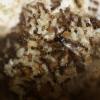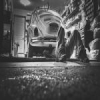- Formiculture.com
- Forums
- Gallery
- Members
- Member Map
- Chat

Liquid food idea
Started By
antabby
, Sep 21 2015 9:07 AM
21 replies to this topic
#1
 Offline
-
Posted September 21 2015 - 9:07 AM
Offline
-
Posted September 21 2015 - 9:07 AM
Hey! I'm new to this site(as a member/poster, I've been browsing the forums for info for a while), so sorry if I say/ask anything that's already been answered.
I have a very small camponotus floridanus colony(8 workers so far). They love hummingbird nectar, but I'm never really sure if they eat the protein I give them(chicken, crickets. They don't seem to respond to anything else).
My question is, would cricket flour/powder be an effective source of protein for ants? As in, will the proteins metabolize(?) the same way as a whole crickets? I know combination diets are iffy, but to me, hummingbird nectar with some cricket powder mixed in seems like it could work.
Has anyone tried this? I'm thinking of trying it this week. And for anyone who doesn't know, cricket flour is dried crickets grinded into a powder
I have a very small camponotus floridanus colony(8 workers so far). They love hummingbird nectar, but I'm never really sure if they eat the protein I give them(chicken, crickets. They don't seem to respond to anything else).
My question is, would cricket flour/powder be an effective source of protein for ants? As in, will the proteins metabolize(?) the same way as a whole crickets? I know combination diets are iffy, but to me, hummingbird nectar with some cricket powder mixed in seems like it could work.
Has anyone tried this? I'm thinking of trying it this week. And for anyone who doesn't know, cricket flour is dried crickets grinded into a powder
- Huch likes this
#2
 Offline
-
Posted September 21 2015 - 9:18 AM
Offline
-
Posted September 21 2015 - 9:18 AM
Most ants will not eat solid foods. They may feed it to their larvae, but they usually drink the juices from the insects and the soft parts.
It would be nearly impoosible to get the correct ratio, as the ratio would change with the brood.
Besides, who wants to eat the same thing week after week? Mot me, and probably not your ants. Variety is key to a healthy colony.
"Always do right. This will gratify some people, and astound the rest." -- Samuel Clemens
#3
 Offline
-
Posted September 21 2015 - 10:51 AM
Offline
-
Posted September 21 2015 - 10:51 AM
Cricket flour?? What is this sorcery and why is this the first time I've heard about it???? Does it dissolve?
Please try this and get back to us!
- antabby likes this
#4
 Offline
-
Posted September 21 2015 - 11:10 AM
Offline
-
Posted September 21 2015 - 11:10 AM
I have a Camponotus sansabeanus colony and I use whey protein for this (chocolate flavored if you're curious). I just mix it in with the liquid food or sometimes sprinkle it on solid food as well. They seem to be growing just fine on it. I don't see why cricket dust wouldn't work as well. I'm just lazy and had the whey protein sitting around.
- antabby likes this
#5
 Offline
-
Posted September 21 2015 - 11:34 AM
Offline
-
Posted September 21 2015 - 11:34 AM
Ants like their protein food fresh and not tinkered around. Some ants will even refuse frozen insects. I don't know, but cricket flour sounds to processed for some ants to even look at. Besides, I like variety and it's good for ants too.
Species I keep:
1 Lasius cf. Neoniger 30 workers
1 Camponotus sp. 15 workers
20 Tetramorium SpE 30 workers
1 T. Sessile 200 workers
#6
 Offline
-
Posted September 21 2015 - 11:34 AM
Offline
-
Posted September 21 2015 - 11:34 AM
Cricket flour?? What is this sorcery and why is this the first time I've heard about it???? Does it dissolve?
Please try this and get back to us!
Supposedly it does! It's recommended to be used as a protein powder supplement and being mixed with regular flour in recipes.
#7
 Offline
-
Posted September 21 2015 - 11:36 AM
Offline
-
Posted September 21 2015 - 11:36 AM
I have a Camponotus sansabeanus colony and I use whey protein for this (chocolate flavored if you're curious). I just mix it in with the liquid food or sometimes sprinkle it on solid food as well. They seem to be growing just fine on it. I don't see why cricket dust wouldn't work as well. I'm just lazy and had the whey protein sitting around.
This is what I do most of the time, but I use vanilla flavored. Hah they do seem to really like it which is where this idea came from.
#8
 Offline
-
Posted September 21 2015 - 12:43 PM
Offline
-
Posted September 21 2015 - 12:43 PM
If they take to this well, please do let us know!
It may be a better alternative than using whey proteins.
#9
 Offline
-
Posted September 21 2015 - 12:51 PM
Offline
-
Posted September 21 2015 - 12:51 PM
There's instructions for making it from live crickets. I was thinking you could get live crickets, plump them up with nutrients and vitamins, then make the powder.
I will definitely update hah
I will definitely update hah
#10
 Offline
-
Posted September 21 2015 - 1:42 PM
Offline
-
Posted September 21 2015 - 1:42 PM
Cricket flour?? What is this sorcery and why is this the first time I've heard about it???? Does it dissolve?
Please try this and get back to us!
An entrepreneur presented this as a healthy, sustainable alternative to regular flour on the show Shark Tank a few seasons ago. IIRC, the investors were not too excited about it going mainstream. ![]()
Assuming they're still in business, yes it is a thing!
Camponotus vicinus, Crematogaster 1, Crematogaster 2, Formica francoeuri, *, *, Myrmecocystus testaceus, Novomessor cockerelli, Pheidole hyatti, Pogonomyrmex californicus, Pogonomyrmex rugosus, Solenopsis invicta
#11
 Offline
-
Posted September 21 2015 - 3:48 PM
Offline
-
Posted September 21 2015 - 3:48 PM
Cricket flour?? What is this sorcery and why is this the first time I've heard about it???? Does it dissolve?
Please try this and get back to us!
An entrepreneur presented this as a healthy, sustainable alternative to regular flour on the show Shark Tank a few seasons ago. IIRC, the investors were not too excited about it going mainstream.
Assuming they're still in business, yes it is a thing!
People need to get over their fear of bugs. Cricket flour is packed with twice the protein of beef, and as much calcium as milk, and costs 2000x less water to make, and much less feed. Bugs are more healthier and environmentally friendlier than mammals to grow. Ants, however, may not want to eat something processed that much.
Species I keep:
1 Lasius cf. Neoniger 30 workers
1 Camponotus sp. 15 workers
20 Tetramorium SpE 30 workers
1 T. Sessile 200 workers
#12
 Offline
-
Posted September 21 2015 - 4:06 PM
Offline
-
Posted September 21 2015 - 4:06 PM
I'm sure Etherwulf may have some thoughts on this, since he used or uses cricket flour.
Firstly, the whole crickets are dried and ground up into small particles—including the fibrous exoskeleton. If you take a whole chicken, or a cow, and grind it up, would you expect it to dissolve in water? I think not.
While the "flour" may technically be combined with water, it is wholly immiscible, and thus will sink to the bottom rather than forming a homogenous solution or even a suspension. In fact, even many free form amino acids are immiscible in water—an issue identified by Straka and Feldhaar in work researching a chemically defined diet for ants.
Notwithstanding this issue, the other problem is that the particle sizes are far too large for most, if any, ant to consume as part of a liquid solution. Ants have a sort of filter that prohibits them from consuming solid foods. And while the particles in these flours may be tiny, they are not small enough to pass through this filter.
In summary, the food will not work.
Firstly, the whole crickets are dried and ground up into small particles—including the fibrous exoskeleton. If you take a whole chicken, or a cow, and grind it up, would you expect it to dissolve in water? I think not.
While the "flour" may technically be combined with water, it is wholly immiscible, and thus will sink to the bottom rather than forming a homogenous solution or even a suspension. In fact, even many free form amino acids are immiscible in water—an issue identified by Straka and Feldhaar in work researching a chemically defined diet for ants.
Notwithstanding this issue, the other problem is that the particle sizes are far too large for most, if any, ant to consume as part of a liquid solution. Ants have a sort of filter that prohibits them from consuming solid foods. And while the particles in these flours may be tiny, they are not small enough to pass through this filter.
In summary, the food will not work.
Edited by drtrmiller, September 22 2015 - 2:53 PM.
- BobJ likes this
byFormica® is the manufacturer of the iconic nectar feeders and Sunburst Ant Nectar.
byFormica ant products always deliver consistent performance, convenience,
and reliability, making them among the most beloved ant foods and kit enjoyed by
ant keeping enthusiasts worldwide. For more information, visit www.byFormica.com.
#13
 Offline
-
Posted September 21 2015 - 4:28 PM
Offline
-
Posted September 21 2015 - 4:28 PM
If you do it, please post the results.
- LC3 likes this
#14
 Offline
-
Posted September 21 2015 - 5:33 PM
Offline
-
Posted September 21 2015 - 5:33 PM
Camponotus vicinus, Crematogaster 1, Crematogaster 2, Formica francoeuri, *, *, Myrmecocystus testaceus, Novomessor cockerelli, Pheidole hyatti, Pogonomyrmex californicus, Pogonomyrmex rugosus, Solenopsis invicta
#15
 Offline
-
Posted September 22 2015 - 12:46 AM
Offline
-
Posted September 22 2015 - 12:46 AM
There appears to be a common misunderstanding in this thread. The objective of this thread is to investigate the formulation of a liquid 'combined' diet for ants incorporating cricket flour as the main protein source but cricket flour is insoluble so it will not dissolve. Hence, any attempts will fail because you'll get a lump of undissolved matter at the bottom.
What I advise is to create a gel or a solid food as per standard practice in formulating artificial ant diets. I wrote a guide a while back detailing every step with all relevant information. http://www.formicult...t-diet-research
Also I have used that particular brand of cricket flour but I find it that it has low receptivity when used on its own. It needs to be mixed together with carbohydrates in order for ants to recruit to it. Otherwise, it will be ignored.
A point on making your own cricket flour. I would advise against it due to the high difficulty in obtaining a desirable yield. Crushing and heating is the general method but I find that it is difficult to obtain a sample of desired purity. Crushing and straining waxworms will work better in this regard but there are problems associated with that as well.
Thus in conclusion, there is really no need for further discussion on making a liquid food with insect flour. Bottom line: it won't work. I would recommend that interested people read up on synthetic diets in scientific literature.
Edited by Etherwulf, September 22 2015 - 6:17 AM.
- drtrmiller likes this
#16
 Offline
-
Posted September 22 2015 - 2:23 AM
Offline
-
Posted September 22 2015 - 2:23 AM
I have generally had poor results processing insects for consumption by ants.
Ants are highly unusual in that raw insects are almost always preferred over ones that have been heated, frozen, dried, or otherwise altered in any way. Assuming the processing is minimal, and the nutrition of the product is comparable to raw, why would this be?
To expand on what Etherwulf mentioned with regard to cricket flour being unsuitable for use on its own, we understand very well that ants perceive their surroundings and the world almost exclusively through smell. Worker ants wander, seemingly randomly (but not really), "smelling" everything with their antennae, and may only judge the potential of a food source when they come into direct contact with it or the odors that emanate from it. In the case of cricket "flour," the cooking, drying, and grinding of the whole insect—an extensive amount of processing—results in denatured proteins, oxidized fats, and the whole product becoming completely unrecognizable from the original, in terms of smell.
There is a quality to insects—and I do not claim to know entirely what it is—in contrast to meat products such as beef, chicken, fish, etc—that renders them unappealing to ants after most any form of processing.
While Etherwulf has added cricket flour to his own gel complete food recipes, which he has documented extensively, there has yet to be any meaningful scientific discussion or comparison, to the best of my knowledge, of a gel diet that contains insect parts, as opposed to other complete diets that have been documented and peer reviewed for a period of many years.
Edited by drtrmiller, September 22 2015 - 2:33 AM.
byFormica® is the manufacturer of the iconic nectar feeders and Sunburst Ant Nectar.
byFormica ant products always deliver consistent performance, convenience,
and reliability, making them among the most beloved ant foods and kit enjoyed by
ant keeping enthusiasts worldwide. For more information, visit www.byFormica.com.
#17
 Offline
-
Posted September 22 2015 - 2:15 PM
Offline
-
Posted September 22 2015 - 2:15 PM
I guess I will muddy the waters a little. Is it possible that the larvae will digest solids and excrete or regurgitate nutrients in a more readily digestible form for the mature ants? I think it is called tropholaxis. I just googled it.
Edited by Huch, September 22 2015 - 2:21 PM.
#18
 Offline
-
Posted September 22 2015 - 2:53 PM
Offline
-
Posted September 22 2015 - 2:53 PM
They will not feed any part of it to larvae, because they will neither recognize it as a food, nor will they be able to collect the sediment of powder gunk that would form in the liquid solution.
- Huch likes this
byFormica® is the manufacturer of the iconic nectar feeders and Sunburst Ant Nectar.
byFormica ant products always deliver consistent performance, convenience,
and reliability, making them among the most beloved ant foods and kit enjoyed by
ant keeping enthusiasts worldwide. For more information, visit www.byFormica.com.
#19
 Offline
-
Posted September 22 2015 - 3:07 PM
Offline
-
Posted September 22 2015 - 3:07 PM
After doing some reading, it looks like some ants do provide larvae food, which in turn regurgitate it for adult ants. That is probably food and species specific. This may not be the same process the op had in mind, but his idea may work. I don't see why adult ants can't carry dissolved or undisolved protein.
The only way to find out if the original posters plan will work is to test it.
The only way to find out if the original posters plan will work is to test it.
#20
 Offline
-
Posted September 22 2015 - 3:20 PM
Offline
-
Posted September 22 2015 - 3:20 PM
Have you tested this before? I think an experiment is the best way to find this out.They will not feed any part of it to larvae, because they will neither recognize it as a food, nor will they be able to collect the sediment of powder gunk that would form in the liquid solution.
I have seen ants eat all sorts of strange mixtures and substances, from crushed sun baked earthworms, insects, and toads to pancakebatter, cheese, and eggs.
Maybe they are not digesting it. That would prove to be a professional kind of experiment. There seems to be good evidence both for and against the plan working.
Anyhow, again though, I think carefully conducted well thought out experiments provide the the best answers. Or, just simply try it.
Edited by Huch, September 22 2015 - 3:26 PM.
0 user(s) are reading this topic
0 members, 0 guests, 0 anonymous users


















